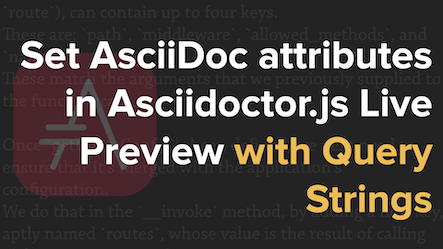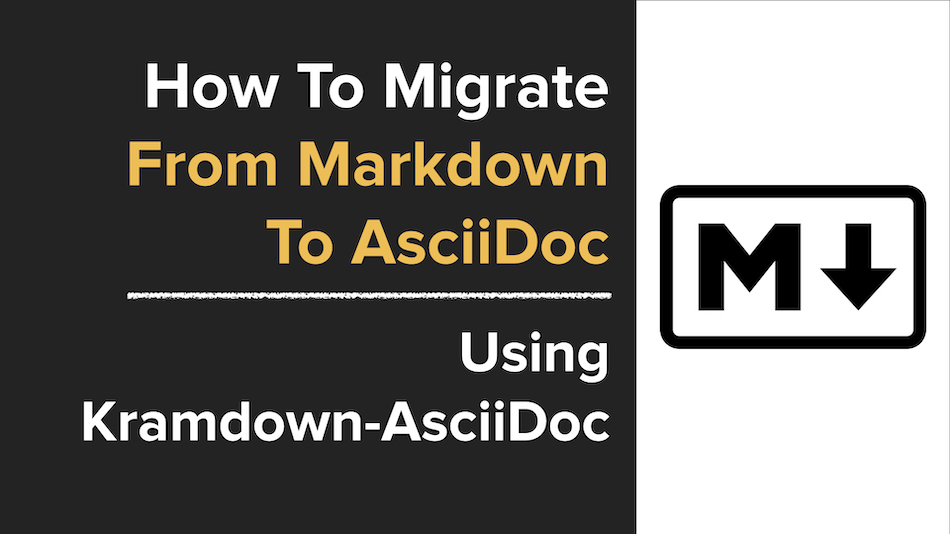
I've Been Using The AsciiDoc Intellij Plugin For a Month. Here's My Review.
I’ve been reviewing the AsciiDoc plugin for IntelliJ over the last four weeks. In this post, I share everything that I learned.

I’ve been reviewing the AsciiDoc plugin for IntelliJ over the last four weeks. In this post, I share everything that I learned.

The Asciidoctor.js Live Preview extension allows custom AsciiDoc attributes to be set using file query strings. In this post, I show you how to do so, along with how to use it in tandem with the extension’s configuration UI.

In this post, I step through how to set custom AsciiDoc attributes in the Asciidoctor.js Live Preview Extension for Firefox (and Chromium/Chrome). By doing so, you can preview your content properly and avoid setting attributes directly in your AsciiDoc content and other hacks.

AsciiDoc can include code from remote sources, not just local files. In this post, I’m going to show you both how to do it, as well as how doing so can make your content extremely flexible and much less intensive to maintain.

Whenever you create online documentation, eventually, the structure needs to change; such as a name change, content restructure, or old content is removed. When these times come, it’s important to create redirects to avoid breaking user expectations. In this post, I’m going to step you through how to do so with Antora.

If you need to convert Markdown content to AsciiDoc, there’s a tool specifically designed for the job — it’s called Kramdoc. In this post, I’m going to show you how to use it and relate my experience with it.
Markdown is one of the most ubiquitous file formats around at the moment for writing technical documentation — and it’s easy to see why! However, it may not be the choice long-term. When it’s time to change, you need to be able to migrate to a more feature-rich format. Come learn about the best tool for the job and how to use it.
Are the words in your technical documentation strong, sharp, direct, and powerful? Or are they passive, weasely, and replete with clichés and adverbs? If you want to make them stronger than they are now, then come learn about write-good.
When you’re reviewing generated HTML content, broken link’s are the last thing you want. However, given the massive amount of documentation in modern projects, manually hunting for broken links isn’t practical. So how do you deal with this problem?

How do you know that your Markdown content is valid? You use MarkdownLint! In this post, I step through how to install, configure, and use it, as well as how to use one-time rule overrides.

Antora is the premier technical documentation platform. However, that doesn’t mean that it’s a breeze to use right from the get-go. If you have just begun using it or want to get the most out of it, this post will step you through the three key concepts that you need to know about.

Anything to do with software and computers usually ends up getting tricky, time-consuming, and repetitive. As such, if you value your sanity, you’ll want to regularly look for ways to automate these tasks away. One of the best ways to do that, is by using Make - a veteran automation tool.

If you need to create and maintain technical writing, there are a large number of solutions that will give you a lot of what you want. However, which one is the best? Today, I’ll show you which one I believe is the best choice.

As I traveled home from PHP Day 2017 in Dresden, I decided to put my thoughts together about the conference, and share them with you, if you weren’t there to enjoy the day yourself.

While I use ReStructuredText, and its companion platform Sphinx-Doc a lot, that doesn’t mean that I believe they’re the best combination for technical writing and documentation.

Do you use Sphinx-Doc and reStructuredText to manage your project’s technical documentation? Do you find that it’s a lot of work to ensure content validates and renders correctly? If so, this post walks through an initial workflow which seeks to make the process easier and more efficient.